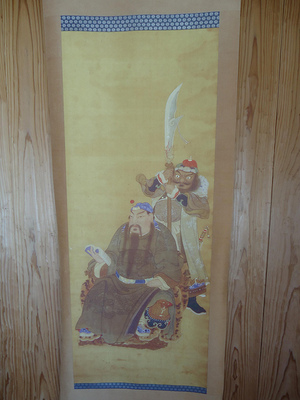Difference between revisions of "Higa Kazan"
From SamuraiWiki
Jump to navigationJump to searchm (LordAmeth moved page Higa Seisei to Higa Kazan: more commonly known name.) |
|||
| Line 1: | Line 1: | ||
| − | [[File:Guanyu-higaseisei.jpg|right|thumb|320px|A painting of [[Guan Yu]] (or, Guān dì wáng) by Higa | + | [[File:Guanyu-higaseisei.jpg|right|thumb|320px|A painting of [[Guan Yu]] (or, Guān dì wáng) by Higa Kazan, on display at the Okinawa Prefectural Museum]] |
*''Born: [[1868]]/12/16'' | *''Born: [[1868]]/12/16'' | ||
*''Died: 1939'' | *''Died: 1939'' | ||
| − | *''Other Names'': | + | *''Other Names'': 盛清''(Seisei)'', 楽水 ''(Rakusui)'' |
| − | *''Japanese'': [[比嘉]] | + | *''Japanese'': [[比嘉]]華山 ''(Higa Kazan)'' |
| − | Higa Seisei was a prominent Okinawan painter of the [[Meiji period]], known especially for his pictures of genre scenes, many of which survive today. | + | Higa Kazan, also known as Seisei, was a prominent Okinawan painter of the [[Meiji period]], known especially for his pictures of genre scenes, many of which survive today. |
Born in Wakasa-machi in [[Naha]], Higa studied painting under [[Sadoyama Anpo|Sadoyama Anpô]] (Mô Eiho)<!--佐渡山安豊・毛永保-->. In [[1908]], at the first exhibition, he participated in the formation of the Tansei Association<!--丹青協会-->. | Born in Wakasa-machi in [[Naha]], Higa studied painting under [[Sadoyama Anpo|Sadoyama Anpô]] (Mô Eiho)<!--佐渡山安豊・毛永保-->. In [[1908]], at the first exhibition, he participated in the formation of the Tansei Association<!--丹青協会-->. | ||
Latest revision as of 10:47, 19 October 2016

A painting of Guan Yu (or, Guān dì wáng) by Higa Kazan, on display at the Okinawa Prefectural Museum
Higa Kazan, also known as Seisei, was a prominent Okinawan painter of the Meiji period, known especially for his pictures of genre scenes, many of which survive today.
Born in Wakasa-machi in Naha, Higa studied painting under Sadoyama Anpô (Mô Eiho). In 1908, at the first exhibition, he participated in the formation of the Tansei Association.
His surviving works include paintings of Guan Yu, Daruma, Okinawan wedding ceremonies, and simply of Okinawan men and women in traditional clothing.
References
- Ryûkyû kaiga ten, Okinawa Prefectural Museum & Art Museum (2009), 95.